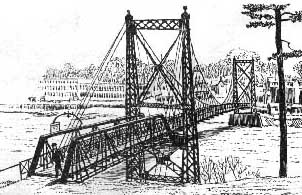 |
Kotlas - Waterville Area Sister City Connection P.O. Box 1747 Waterville, ME 04903-1747 Write to Us |
 |
![[Show table of contents & options]](../../questionsign.gif)
 |
Kotlas - Waterville Area Sister City Connection P.O. Box 1747 Waterville, ME 04903-1747 Write to Us |
 |
|
Home > Impressions > Summer 2002 |
![[Show table of contents & options]](../../questionsign.gif) |
If you are viewing this newsletter without the table of contents, click the question mark sign anywhere that it appears to display the table of contents and other options. |
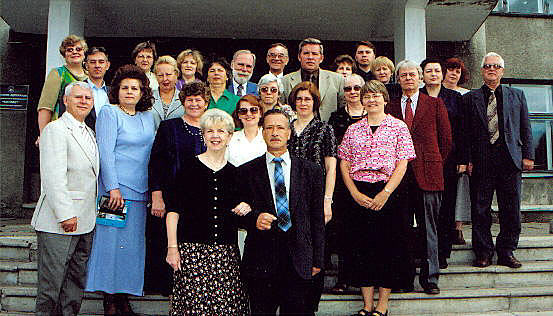
A group portrait on the steps of city hall after the meeting with the mayor. In the front are Pauline Mayhew and Vycheslav ("Slava") Chernykh, founder of the sister city effort in Kotlas and member of the first delegation from Kotlas in June 1990. To learn the identities of the other people in the picture, click on their faces. (This may not work in older browsers.) Photo supplied by Ellen Corey. |
by Gregor Smith
On August 5, eleven members of the Kotlas Connection left Waterville for a two-week visit to Moscow, Kotlas, and St. Petersburg, Russia. They were the first large delegation to visit Kotlas since the Rivers Project students went over in July 1999.
Flying from Portland to Moscow, via New York and Helsinki, the group spent two days and two nights in Russia's capital. They toured the city by bus and the Kremlin on foot and also made a side trip to the historic town of Sergiyev Posad (called Zagorsk during the Communist era), the site of a 14th century, walled monastery that is the seat of the Russian Orthodox patriarch.
While in Moscow, the group also met Sasha Shubin, a school principal turned businessman, who is now national sales manager for Yarpiva, a Russian brewer. Originally from the Kotlas suburb of Vychegodsky, Shubin spent four months, in the winter and spring of 1995, in the Waterville area as a guest of the Kotlas Connection.
Leaving Moscow, the delegation took a day-long train trip to Kotlas, where they spent four days and nights. While in Kotlas, the delegation spent about half their time separately, with their host families, and half their time together, in group activities. The latter included formal meetings with the mayor and the sister city committee and a day trip to the nearby town of Velikiy Ustyug. There they toured historic churches; a new theme park dedicated to Grandfather Frost, the Russian Santa Claus; and a museum established in honor of Sergei Preminin, a young seaman from an outlying village who died to save the lives of his crewmates aboard a doomed submarine. (For more about Sergei Preminin and the museum, see our Summer/Fall 1999 newsletter.)
After another day long train trip, they arrived in St. Petersburg for a 4½ day stay. In St. Petersburg, the group toured the Hermitage, which houses one of the world's greatest art collections. They also made side trips to Novogorod, one of Russia's oldest cities, which has many medieval Orthodox churches, a working monastery, and a museum village of wooden structures brought from all over Russia; and to Petrodvorets, site of the tsars' lavish, 18th century, summer palace, now a museum. On August 19 the group flew back to the United States.
The delegation included several members of the executive committee: Jack and Pauline Mayhew of Vassalboro, Mary Coombs of Winslow, Ellen Corey of South China, and Herb Foster and Phil Gonyar of Waterville. Also going were Julie Stowe of Waterville, Joan Taczli of Chelsea, Mary Ellen Miner of Augusta, and Connie and Tom Cooney of Morrisville, Vt. The Mayhews, Mary Coombs, and Phil Gonyar have all been to Kotlas several times; the other travelers were first time visitors to our sister city.
Several of the travelers have written essays about the trip. We have also prepared an online slide show of their pictures.
![[Show table of contents & options]](../../questionsign.gif) |
Kotlas Impressions 2002 |
By Jack Mayhew
The sight of the Northern Dvina River and the newly constructed bridge spanning it welcomed us as our train arrived in Kotlas. The new bridge that we would come to cross on several occasions has enhanced personal travel and will certainly facilitate commercial and economic opportunities to the area.
This was our third visit to Kotlas; our last visit had been in 1996. As in previous visits, dear friends hosted our home stay. It was wonderful to visit and spend time with them. They are actually more like family to us than just friends. [The Mayhews were hosted by Grigory and Irina Reznichenko, who had also hosted them on their previous visit. The Mayhews, in turn, hosted Irina Reznichenko when she and three other Kotlassians spent two weeks in the Waterville area in the fall of 1998.] Our circle of Kotlas friends are many; we are always so eager to see them and, of course, to meet new friends too.
Each visit is a warm and meaningful experience. The kindness, friendship, generosity and thoughtfulness we receive is just overwhelming. We had the opportunity to visit their dachas, share food, beverage and socialize with our gracious hosts. Going to the banya [sauna] of course was a real treat.
The significant events during our Kotlas visit included the opportunity to finally meet Mayor Alexander Shashurin and members of his administration. The meeting at Lyceum #3 with the Waterville Committee was also proactive; the agenda items we discussed reinforced the goals our Committees share.
We visited the Kotlas "Baby House", where we had the pleasure to meet with the Director, make a donation, and have a brief tour. Some of the children performed songs and recited. It was a very moving experience
In this children's orphanage, the ages range from infants to 6 years old. The staff work wonderfully with the children and spend a lot of one-on-one time with them.
Our Kotlas visit also enabled us to visit historical and cultural sites that are within reasonable travel distances to Kotlas. Noteworthy were the Kotlas and Krasnoborsk museums, the Sergei Preminin museum and memorial in Krasavino, and the churches, souvenir shops and Grandfather Frost theme park in Velikiy Ustyug.
![[Show table of contents & options]](../../questionsign.gif) |
Impressions of Russia |
By Herb Foster
Since this was my first trip to Russia, my mind is naturally full of impressions — some very clear, others still quite muddled. I think the one thing that stands out now is my surprise at finding out that things were not at all as I had expected. The people we met were very happy and extremely friendly, and certainly not as lacking in material things as I had imagined.
Our guide in Moscow, a wonderful gal named Irina, took us to a grocery store on our last day there to buy supplies for the 23-hour train ride to Kotlas. When we commented on the availability — and reasonable prices — of everything we needed, she replied, "Oh, you can get everything you want now in Moscow. What we need now is the money to buy it." To me, this was the biggest shock, as I had the impression that material goods, and especially food, were hard to come by. I found myself wishing that I could have been part of an earlier delegation so that I could have more fully experienced the differences that the last five years have brought.
My second surprise came from seeing that people in Russia seem very happy. Probably this goes hand in hand with the growing availability of goods and services. Almost everyone that we met owns a cozy apartment with adequate appliances, and has a car or has a friend with a car. And those who don't sincerely believe that it's just a matter of time before they do. On one occasion I visited a family living in an obshcheetye, a dormitory-like building, where the rooms have been made into mini-apartments. Their whole apartment was probably 20' × 20'. I also had occasion to spend a lot of time in a communal apartment, where eight people in four different families live together, sharing one kitchen and bath and toilet facilities. In both cases the hallways were admittedly depressing — the result of no one's having been given responsibility for them when the buildings were subdivided. But, again in both cases, the living quarters were bright and inviting, with a cheeriness that reflected the owners' attitude. I only hope that we, the Kotlas Committee, can in some small way contribute to the growing sense of optimism that seemed to be everywhere we went.
![[Show table of contents & options]](../../questionsign.gif) |
The Kotlas Economy is Improving |
By Phil Gonyar
One of the interesting changes I observed in Kotlas was the increase in private enterprise. Immediately after our arrival in Kotlas our group visited a retail furniture store. It has a multi-level, multi-room display area with everything needed to furnish a home or apartment. There is also a small tailoring operation within the business. Customers can finance their purchases. [In Soviet times, stores did not offer credit; the customer always had to pay cash.] After a tour and explanation, we were treated to an excellent meal. [See Julie Stowe's essay below for more about this visit visit.]
A day later Herb Foster and I spent time with the editor and owner of the local private newspaper, Evening Kotlas. He was very interested in our social support system for the elderly and the children. The editor is optimistic about the future of the newspaper. He sees that when the government stops supporting financially the current public newspapers — scheduled to occur in the next couple of years — he will be well positioned.
Another day Nikolai Sheptyakov, my host, took me to visit a bee farm. [Sheptyakov is a journalist and long time supporter of the sister city effort, having visited Waterville in June 1990.] Here an enterprising family has begun to produce honey. They currently have 65 hives and plan to expand to 200. After being properly covered with nets, I took a closer look at the hives and bees at work. A comb was removed, and I tasted the sweet product of the bees. Success!!! No stings.
My pen pal is an example of the change in economic structure. A former teacher, he now is heavily engaged in retail sales. From several successful shops he sells baked goods produced in his own bakery. His shops sell other products that he buys wholesale and sells retail. [Sergei Pirogovski is from Koryazhma, a town 20 miles upriver from Kotlas. Before the breakup of the Soviet Union, he taught English at a local school.]
While I did not actually visit other sites, I observed private apartments being constructed, banks doing business, and other signs of an improved economy. Private enterprise is growing.
![[Show table of contents & options]](../../questionsign.gif) |
A Custom-Made Dress |
By Julie Stowe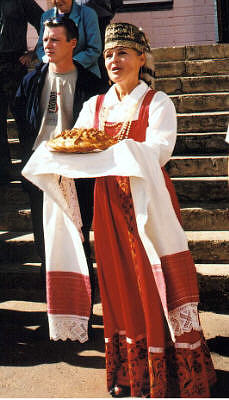
When we arrived in Kotlas, one of the first places to which we were taken was a furniture store, an example of a successful local business. At the doorstep we were greeted with the traditional bread and salt. The photo shows the woman who greeted us with a song wearing traditional costume.
In addition to the well-stocked showrooms we saw, the owner has built a chain of ten stores with a fleet of delivery trucks since 1993, and the stores offer credit. The furniture was slightly different from what you'd see around here in that it was geared more toward apartment living — smaller, lighter, pieces and a lot of living room furniture that converts to beds.
The store also carries window dressings and fabric and makes custom clothing. After our tour, Lyuba Zinovkina, my host while in Kotlas, asked if I would be interested in ordering a custom-made dress. After a moment of surprise, I agreed, and I'm very glad I did. Pauline and Ellen also agreed to order dresses. We were given a selection of American-made fabric to choose from and magazines from which to choose a style. As I was short on ideas at the moment and the selection was fairly narrow, I chose a style similar to one that had been modeled for us — a dark green dress with a slightly flared skirt and princess seams. We were measured from head to toe, then ushered to a side room, where we rejoined our group.
Tables had been set up for what was either a meal or a very elaborate tea. Our meal consisted of caviar and blini (Russian pancakes), cold meats and other delicacies, vodka, wine, and mineral water, and a variety of fabulous pastries to go with the tea. I particularly remember one pastry that was topped with pink frosting in the shape of a little pig. Someone at my table picked it up to exclaim how wonderful it was, then suddenly dropped it upside down, flattening the little pig!
On the following day, we returned to the store for our dress fitting. Our dresses had been cut out and pinned together, and we put them on so that the seamstress could adjust the fit. My Russian seamstress didn't speak any English, and I didn't speak any Russian, but it was easy to communicate by drawing a neckline with my finger and lifting the hemline to where I wanted it. We really felt quite pampered. In the past I've tried sewing some pieces of clothing for myself and adjusting the fit, and I'm well aware of how difficult it can be. I was in good hands, though. Two days later, when we went back to pick up our dresses, the fit was perfect. And the cost was only 735 rubles — about $25!
Julie Stowe is coordinator of publications and web sites for Alumni Relations and the Development offices at Colby College. She had not previously been to Russia or studied Russian, but is now auditing a beginning Russian course at Colby.
![[Show table of contents & options]](../../questionsign.gif) |
Just One Day |
By Ellen Corey
This was my first visit to Russia, and even though Kotlas committee members who had been there before told us that the Waterville Committee would have plenty of interesting things to fill our schedule, I was still amazed at how much activity we crammed into our four-day stay. On August 12, my hostess, Zina Zelyanina, accompanied me on the day's tour. Zina and I have been corresponding for ten years, and I was so happy we would be able to spend this day together. I felt like I had been neglecting her because so many of our official visits excluded her.
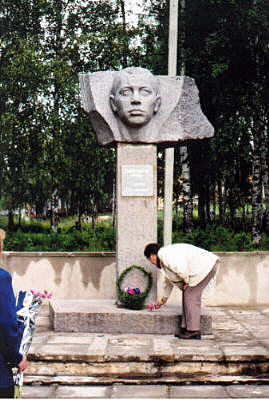 Memorial to Sergei Preminin in Krasavino. Zina Yegorova is placing a flower on the base. Photo by Ellen Corey. |
Our group had a chartered bus for the day. Our first stop was the town of Krasovino to visit the memorial to Sergei Preminin, whose story is documented in the book Hostile Waters. Preminin, a sailor serving on a nuclear submarine operating off the U.S. coast, volunteered to shut down the malfunctioning electrical system to prevent a meltdown, and he and three other sailors died. Our interpreter said that if he had not succeeded there would have been a nuclear catastrophe worse than Chernobyl. Part of the grammar school he attended has been turned into a museum honoring him and the other members of the crew. The tour guide is his former teacher. While the teacher was explaining how Preminin died, I put my arm around the sobbing woman standing next to me, and later learned that she is Preminin's aunt. Preminin's parents were there, too, and joined us for the reception with the mayor. They looked so sad and forlorn, even after all these years. After the museum tour, we visited the stone monument to Preminin, where it is now the custom to lay flowers for all official occasions. [For more about Sergei Preminin, see Phil Gonyar's essay from his previous visit in 1999.]
Our next stop was the ancient town of Velikiy Ustyug. Although the town has long been famous for its churches, many of which escaped destruction by the Bolsheviks, signs leading into town now proclaim it the official birthplace of Grandfather Frost. And they're serious. The Russians are building a large tourist complex around their popular folk tale. It's intended for Russian tourists, but they'll be happy to get foreign guests as well. We had time to see only Grandfather Frost's official residence. This place is light years beyond Santa's Village [a Santa Claus theme park with rides and games] in New Hampshire. Santa's Village is cute, but tacky. Adults know better than to look too closely at materials and workmanship. Grandfather Frost's official residence, on the other hand, is a feast for the eyes. Both inside and out, it's a masterpiece of Russian woodcraft. It took three months to build because they wanted to follow old techniques and use as few nails as possible. Towns, businesses, and rich individuals have contributed top-of-the-line Russian crafts to furnish it — carved wood, nesting dolls, painted wood, silver, linen, furniture! Believe me, Christopher Lowell would kill for the bed frame alone. [Christopher Lowell is an interior decorator and host of the eponymous program on the Discovery Channel.] There is more going on here than a tourist attraction. The grown-ups in Russia really believe in Grandfather Frost, who is not to be confused with Santa Claus. Last year the official Santa Claus of Finland paid an official visit to the official Grandfather Frost of Russia and it was official big news. Grandfather Frost himself came in especially to meet us. He was about 6' 8" and had a deep booming voice. Other members of the tour said they had glimpsed his legs under his long red robe, and no, he really wasn't on stilts or platform shoes. My Zina was as happy as any kid to have her picture taken with him.
![[Show table of contents & options]](../../questionsign.gif)
We stopped for a catered lunch at one of the new private restaurants — beef in beer, potatoes, salad, chopped cabbage and scallions, dill pickles, bread, cake and tea. Advice to anyone contemplating a trip to Russia: leave your diet at home. I think the restaurant stop was one of five meals I ate that day.
Velikiy Ustyug has great souvenir shopping at great prices. Wonderful linens and birch bark at a great store that still uses an abacus and follows the old Soviet system of paying for your purchases and going back to the counter to get your goods. We shopped till we dropped at the factory that makes northern blackwork silver. (Blackwork silver is a secret layering process that produces an intricate black design on silver.) There seemed to be beautiful churches everywhere. It's amazing how, although they all follow the same general construction plan, each is unique. We visited one of them that is now operating as a museum. I wish I could write an intelligent descriptive paragraph about it, but I didn't take any photos inside and by that time churches were kind of blurring into one another. I do remember how old it was and how steep the stone staircase. Pity anyone who slipped on it.
On the way back to Kotlas, the bus stopped by the side of the road and we were all told to get out. More than a little bewildered, we complied, wondering if we were being marooned in the Russian countryside. Our friend Lyuba pointed to the gas station on the opposite side of the road. We still looked perplexed, so she had to explain that for the safety of the passengers, everyone is required to disembark while the bus is gassing up.
Those of us who had taken advantage of the wonderful opportunity to buy a custom-made dress at the Moscow Woman Furniture Store went there to pick up our dresses. They were great.
I had expected to go back to my Zina's house, but instead we went to our friend Inna Tushina's dacha. At first I was a little panic-stricken when I was told I would spend the night there. We had all been instructed to get our packing done that night because there would be no time the next day. Inna told me not to worry — they'd have me back to the dacha where I had been staying very early the next morning. So I had a wonderful evening touring Inna's large garden, which she dearly loves. She had told me on my first night that she wanted me to use her banya as well as my Zina's, because hers was better, a dry heat sauna instead of a steam bath. During the banya, we talked a lot about what I do as a daily routine. They seemed genuinely surprised to learn that I clean my own house. We talked about the necessity of relaxing and about how Americans seldom do. We had beer and packaged snacks of salted, shredded lobster. I must say I enjoyed both banyas equally well. That is one Russian custom I would really like to replicate here. After the banya, we ate again (surprise!). Inna's husband, Yuri, had prepared tea in a genuine samovar, and we drank it with cookies, candy and watermelon. We got to bed at midnight and, true to their promise, they had me up at 5:30 the next morning in plenty of time to get back to Zina's dacha and pack my bags.
![[Show table of contents & options]](../../questionsign.gif) |
Not All Change Is Progress |
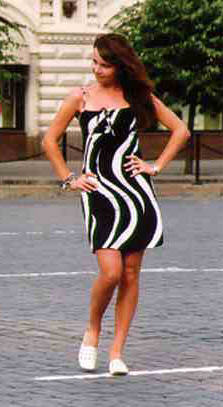
A study in contrasts: a young woman in Red Square and an elderly woman in Sergiyev Posad. Both photos are by Mary Ellen Miner. The picture of the babushka won a blue ribbon for photography at the Common Ground Country Fair in Unity in September. 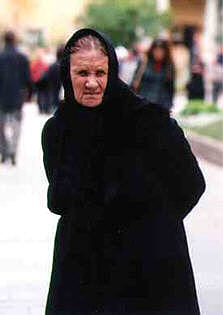
|
By Mary Ellen Miner
A shout went up when the newly completed bridge across the Northern Dvina River was spotted from the train. Knowing how long it has been under construction and how significant it is that Kotlas is now linked to the north and east by highway, we studied it with great interest. What I, a first-time visitor to Kotlas, did not realize at the time was the extent to which that bridge symbolizes numerous, long delayed, freshly forged links in Kotlas and throughout Russia.
A country of strong traditions that date back many hundreds of years, at this point in its history Russia is a study in contrasts. Babushkas and bikinis, New Russians and new poverty, crime and cathedrals, Ladas and Lenin's tomb, tradition and telecommunication all co-exist in a country that is racing into the 21st century even as it continues to embrace its proud past. As Americans, we supposedly are the diverse ones. However, the rapidly evolving social, political, economic, educational and technological changes our group observed on a small scale in Kotlas, and far more in Moscow and St. Petersburg, left me feeling that Russia is a country which will very soon struggle to bring and keep together its own diverse population.
The greatest struggle may well focus around the question of which changes are progress and which are not. Our Kotlas friends told us they are trying to catch up with America, yet during our visit to their wonderful city and dachas we saw solidly in place many of the important values and practices that America has lost: closeness to the land; a slower pace of life; a strong sense of family, community and history; pride in a job well done. I wanted to shout, "No, don't 'catch up' with us, please! In many ways you're closer to the goal than we are. Take the time to weigh which changes are positive ones and which are actually a step backward."
Because it will make such a long leap in such a short time, Russia has the opportunity to learn from our mistakes. I hope the Kotlas people, who are standing on the brink of change, will take from the 21st century only the things that will truly make their lives better, and will wisely keep the things that bind them together and make them unique. Russian tradition: don't let it hold you back, but don't ever, ever leave it behind.
Mary Ellen Miner teaches gifted and talented children in Augusta's four elementary schools. She also coordinates services for the gifted and talented in grades K-8. This was her first trip to Russia.